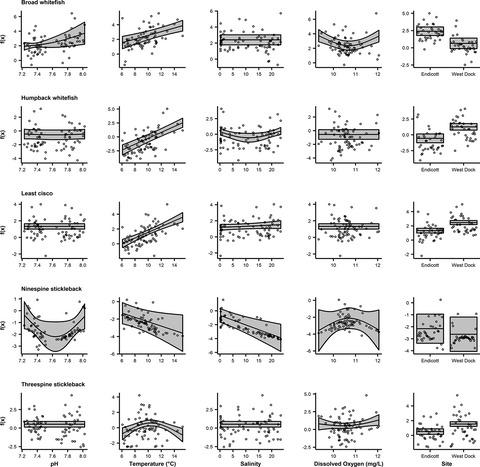当前位置:
X-MOL 学术
›
Ecol. Evol.
›
论文详情
Our official English website, www.x-mol.net, welcomes your feedback! (Note: you will need to create a separate account there.)
Characterization of the abiotic drivers of abundance of nearshore Arctic fishes
Ecology and Evolution ( IF 2.6 ) Pub Date : 2021-07-22 , DOI: 10.1002/ece3.7940 Noah S Khalsa 1, 2 , Kyle P Gatt 2 , Trent M Sutton 2 , Amanda L Kelley 2
Ecology and Evolution ( IF 2.6 ) Pub Date : 2021-07-22 , DOI: 10.1002/ece3.7940 Noah S Khalsa 1, 2 , Kyle P Gatt 2 , Trent M Sutton 2 , Amanda L Kelley 2
Affiliation

|
Fish are critical ecologically and socioeconomically for subsistence economies in the Arctic, an ecosystem undergoing unprecedented environmental change. Our understanding of the responses of nearshore Arctic fishes to environmental change is inadequate because of limited research on the physicochemical drivers of abundance occurring at a fine scale. Here, high-frequency in situ measurements of pH, temperature, salinity, and dissolved oxygen were paired with daily fish catches in nearshore Alaskan waters of the Beaufort Sea. Due to the threat that climate change poses to high-latitude marine ecosystems, our main objective was to characterize the abiotic drivers of abundance and elucidate how nearshore fish communities may change in the future. We used generalized additive models (GAMs) to describe responses to the nearshore environment for 18 fish species. Relationships between abundance and the physicochemical environment were variable between species and reflected life history. Each abiotic covariate was significant in at least one GAM, exhibiting both nonlinear and linear associations with abundance. Temperature was the most important predictor of abundance and was significant in GAMs for 11 species. Notably, pH was a significant predictor of abundance for six species: Arctic cod (Boreogadus saida), broad whitefish (Coregonus nasus), Dolly Varden (Salvelinus malma), ninespine stickleback (Pungitius pungitius), saffron cod (Eleginus gracilis), and whitespotted greenling (Hexagrammos stelleri). Broad whitefish and whitespotted greenling abundance was positively associated with pH, while Arctic cod and saffron cod abundance was negatively associated with pH. These results may be a bellwether for future nearshore Arctic fish community change by providing a foundational characterization of the relationships between abundance and the abiotic environment, particularly in regard to pH, and demonstrate the importance of including a wider range of physicochemical habitat covariates in future research.
中文翻译:

近岸北极鱼类丰富的非生物驱动因素的表征
对于北极地区的自给经济而言,鱼类在生态和社会经济方面至关重要,北极的生态系统正在经历前所未有的环境变化。我们对近岸北极鱼类对环境变化的反应的理解是不够的,因为对小规模丰度的物理化学驱动因素的研究有限。在这里,对 pH 值、温度、盐度和溶解氧的高频原位测量与波弗特海近岸阿拉斯加水域的每日鱼类捕获量配对。由于气候变化对高纬度海洋生态系统构成威胁,我们的主要目标是描述丰度的非生物驱动因素,并阐明未来近岸鱼类群落可能发生的变化。我们使用广义加性模型 (GAM) 来描述 18 种鱼类对近岸环境的反应。丰度与物理化学环境之间的关系因物种而异,反映了生活史。每个非生物协变量在至少一个 GAM 中是显着的,表现出与丰度的非线性和线性关联。温度是丰度的最重要预测因子,并且在 11 个物种的 GAM 中具有重要意义。值得注意的是,pH 值是六种物种丰度的重要预测指标:北极鳕鱼(温度是丰度的最重要预测因子,并且在 11 个物种的 GAM 中具有重要意义。值得注意的是,pH 值是六种物种丰度的重要预测指标:北极鳕鱼(温度是丰度的最重要预测因子,并且在 11 个物种的 GAM 中具有重要意义。值得注意的是,pH 值是六种物种丰度的重要预测指标:北极鳕鱼(Boreogadus saida )、阔白鲑 ( Coregonus nasus )、Dolly Varden ( Salvelinus malma )、九尾棘鱼 ( Pungitius pungitius )、藏红花鳕鱼 ( Eleginus gracilis ) 和白斑青鱼 ( Hexagrammos stelleri)。宽阔的白鲑和白斑青鱼丰度与 pH 值呈正相关,而北极鳕鱼和藏红花鳕鱼的丰度与 pH 值呈负相关。这些结果可能是未来近岸北极鱼类群落变化的风向标,通过提供丰度与非生物环境之间关系的基本特征,特别是在 pH 值方面,并证明在未来研究中包括更广泛的物理化学栖息地协变量的重要性.
更新日期:2021-08-16
中文翻译:

近岸北极鱼类丰富的非生物驱动因素的表征
对于北极地区的自给经济而言,鱼类在生态和社会经济方面至关重要,北极的生态系统正在经历前所未有的环境变化。我们对近岸北极鱼类对环境变化的反应的理解是不够的,因为对小规模丰度的物理化学驱动因素的研究有限。在这里,对 pH 值、温度、盐度和溶解氧的高频原位测量与波弗特海近岸阿拉斯加水域的每日鱼类捕获量配对。由于气候变化对高纬度海洋生态系统构成威胁,我们的主要目标是描述丰度的非生物驱动因素,并阐明未来近岸鱼类群落可能发生的变化。我们使用广义加性模型 (GAM) 来描述 18 种鱼类对近岸环境的反应。丰度与物理化学环境之间的关系因物种而异,反映了生活史。每个非生物协变量在至少一个 GAM 中是显着的,表现出与丰度的非线性和线性关联。温度是丰度的最重要预测因子,并且在 11 个物种的 GAM 中具有重要意义。值得注意的是,pH 值是六种物种丰度的重要预测指标:北极鳕鱼(温度是丰度的最重要预测因子,并且在 11 个物种的 GAM 中具有重要意义。值得注意的是,pH 值是六种物种丰度的重要预测指标:北极鳕鱼(温度是丰度的最重要预测因子,并且在 11 个物种的 GAM 中具有重要意义。值得注意的是,pH 值是六种物种丰度的重要预测指标:北极鳕鱼(Boreogadus saida )、阔白鲑 ( Coregonus nasus )、Dolly Varden ( Salvelinus malma )、九尾棘鱼 ( Pungitius pungitius )、藏红花鳕鱼 ( Eleginus gracilis ) 和白斑青鱼 ( Hexagrammos stelleri)。宽阔的白鲑和白斑青鱼丰度与 pH 值呈正相关,而北极鳕鱼和藏红花鳕鱼的丰度与 pH 值呈负相关。这些结果可能是未来近岸北极鱼类群落变化的风向标,通过提供丰度与非生物环境之间关系的基本特征,特别是在 pH 值方面,并证明在未来研究中包括更广泛的物理化学栖息地协变量的重要性.



























 京公网安备 11010802027423号
京公网安备 11010802027423号